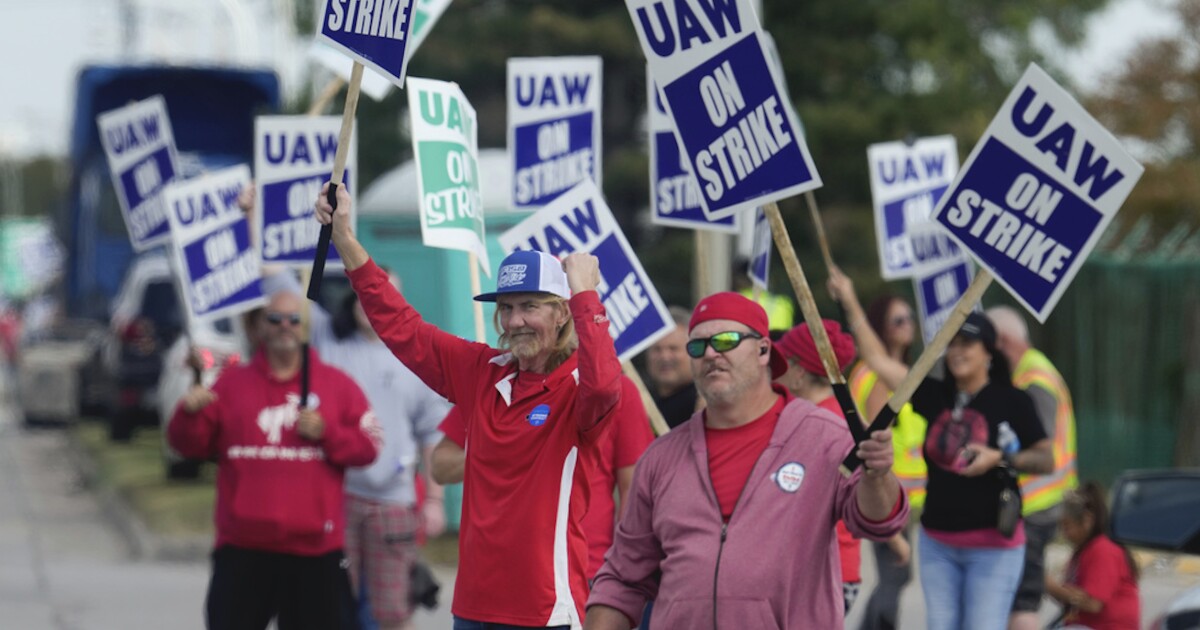

One of the more interesting requests in the UAW negotiations with the “Big Three” automakers is a four-day workweek, an arrangement that is quickly growing in popularity.
At one time, the idea of a four-day workweek might have seemed like a ridiculous request by the United Auto Workers, which is currently locked in a historic strike amid stalled contract talks. But the idea has gained some steam and has some very prominent advocates.
HOUSE OVERSIGHT LAUNCHES INVESTIGATION INTO GRANHOLM ELECTRIC VEHICLE ROAD TRIP
“There clearly is a lot of interest in this. The fact that you see United Auto Workers putting this in their request means that this is not a topic that is going to go away anytime soon,” Chris Kayes, professor of management at George Washington University, said of the four-day workweek’s growing popularity.
The fact the UAW is raising the idea of a four-day workweek is particularly notable because it is part of a broader, multi-decade trend toward shortening the workweek that the auto industry has played a major part in. Kayes said the trend goes back about a century to the era of Henry Ford, when his company pared the workweek down to just five days.
Ford adopted the policy in 1926, becoming one of the first companies to do so, and over the years, the 40-hour, five-day workweek became par for the course.
“So there is a lot of history in the automotive industry in particular around looking to shorten the workday, and this is kind of just the next evolution I think in that trend, although it’s 100 years later,” Kayes told the Washington Examiner.
A few pilot studies of the four-day workweek have shown some success, bolstering arguments from proponents. The results of the most notable one, which involved 61 employers and nearly 3,000 workers, were released earlier this year and gained considerable attention.
Of those 61 participating companies, nearly 92% said that they would continue to test the four-day workweek after the trial concluded, and 18 of the companies said they will be making the changes permanent. That is because the change showed some major benefits not only for workers but also for employers, who are typically skeptical about the notion of shorter workweeks.
“At the beginning, this was about pandemic burnout for a lot of employers. Now it’s more of a retention and recruitment issue for many of them,” said Juliet Schor, an economist and sociologist at Boston College.
Additionally, employers in the study rated worker productivity on a scale of 0 to 10 — 0 being very negative and 10 being very positive. The average rating from the pilot was 7.5. Halfway through the trial, nearly half of the employers reported little to no changes in productivity, 34% reported a slight improvement, and 15% said the four-day workweek had led to a significant improvement in productivity.
Another factor driving interest in the four-day workweek is the tight labor market, according to Kayes.
A major problem for employers over the past few years is worker recruitment and retention. Basically, companies are struggling to hire and hold on to employees, so workers have been able to exact concessions like higher pay and better hours in exchange for their labor.
The desire to attract talent in such a competitive market has led some companies to switch to four-day schedules. There are even some examples of this in the public sector, Kayes said, pointing out that some school districts have moved to four-day workweeks in order to attract teachers.
There has also been a “changing sociological contract” between employers and employees, Kayes added. He said that in recent years since the pandemic, workers have been reevaluating how important work is to them and value other benefits other than salary alone when considering a job.
Rebecca Bennett, a professor at the University of Central Florida and the chairwoman of the school’s Department of Management, told the Washington Examiner that the COVID-19 pandemic helped spur the power dynamic shift in the labor market, which gave rise to what has been dubbed the “great resignation.” She said the transition toward work-from-home caused people to reevaluate their relationship with work.
“I think with COVID and so many people working from home, [it] kind of became a thing where people could work their own hours,” Bennett said, “so maybe you chose to work four longer days or you just got your work done, people realized well it’s more about getting the work done than being at the office and filling a seat for a certain amount of hours.”
There are some notable cons to a four-day workweek. For one, it could reduce teamwork, as employees might be assigned to come in or work on different four-day schedules, making collaboration more difficult, Kayes said.
He said some offices might also implement higher levels of control and monitoring for employees to ensure they are productive during the shorter workweeks.
Additionally, even with the trials, only a small number of companies across the U.S. have actually implemented four-day workweeks, so there isn’t an enormous pool of companies to evaluate when looking at success.
As for the UAW’s demands, Arthur Wheaton, director of labor studies at Cornell University’s School of Industrial and Labor Relations, told the Washington Examiner that he doesn’t expect that a four-day workweek will end up in the contract but said the proposal is likely to be used to shine light on other concerns, particularly that workers have been overworked.
CLICK HERE TO READ MORE FROM THE WASHINGTON EXAMINER
“It’s like, ‘You know what, this really doesn’t work for us very well,’” he said of the auto employees who end up working more than 40 hours per week. “‘So if you want us to do that kind of activity, we’ll counter with 32 [-hour workweeks] at 40-hour pay.’”
“But I don’t realistically expect that to be in the final agreement,” Wheaton said, noting there are also logistical problems with implementing such a plan for a moving assembly line.





